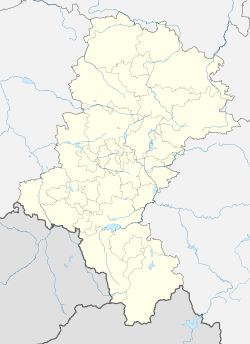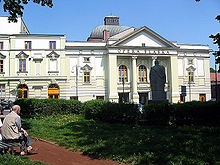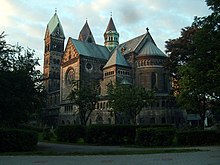Bytom
| Bytom | |||
|---|---|---|---|
 From top, left to right: Silesian Opera, Historic tram (in background Main Post Office), Dworcowa Street, Market square, Szombierki Heat Power Station, High school on Władysław Sikorski Square, The church of St. Margaret | |||
| |||
 Bytom Show map of Silesian Voivodeship  Bytom Show map of Poland | |||
Coordinates: 50°20′54″N 18°54′56″E / 50.34833°N 18.91556°E / 50.34833; 18.91556 | |||
| Country | Poland | ||
| Voivodeship | Silesian | ||
| County | city county | ||
| Established | 12th century | ||
| Town rights | 1254 | ||
| Government | |||
| • Mayor | Damian Bartyla | ||
| Area | |||
| • City | 69.44 km2 (26.81 sq mi) | ||
| Highest elevation | 330 m (1,080 ft) | ||
| Lowest elevation | 249 m (817 ft) | ||
| Population (2009) | |||
| • City | 183,251[1] | ||
| • Urban | 2,746,000 | ||
| • Metro | 4,620,624 | ||
| Time zone | UTC+1 (CET) | ||
| • Summer (DST) | UTC+2 (CEST) | ||
| Postal code | 41-900–41-936 | ||
| Area code(s) | +48 32 | ||
| Car plates | SY | ||
| Website | http://www.um.bytom.pl/ | ||
Bytom (Polish pronunciation: [ˈbɨtɔm] (![]() listen); Silesian: Bytůń, German: Beuthen O.S.) is a city in Silesia in southern Poland, near Katowice. It lies in the central-western district of the Upper Silesian Metropolitan Union – a metropolis with a population of 2 million. Bytom is located in the Silesian Highlands, on the Bytomka river (tributary of the Kłodnica).
listen); Silesian: Bytůń, German: Beuthen O.S.) is a city in Silesia in southern Poland, near Katowice. It lies in the central-western district of the Upper Silesian Metropolitan Union – a metropolis with a population of 2 million. Bytom is located in the Silesian Highlands, on the Bytomka river (tributary of the Kłodnica).
The city has belonged to the Silesian Voivodeship since its formation in 1999. Previously it was in Katowice Voivodeship. Bytom is one of the cities within the conurbation of the Katowice urban area (total population approximately 2.7 million) as well as within a greater Silesian metropolitan area populated by about 5,294,000 people.[2] The population of the city is 183,251 (June 2009).[1]
Contents
1 Geography
1.1 Geology
2 Coat of arms
3 History
4 Economy
5 Public transport
6 Sport
7 Culture
8 Education
9 Confederation of Silesia
10 Politics
10.1 Bytom/Gliwice/Zabrze constituency
11 Notable people
12 References
13 External links
Geography

Districts of Bytom.
Bytom is located on the range "Bytom-Katowice", in the Upland of Miechowice, which is in turn a central part of the Silesian Upland. The city straddles between north latitudes 50°19′ i 50°26′ and east longitudes 18°47′ i 18°58′. It reaches 346 m (1,135 ft) at the highest point, in wildlife reserve of Segiet, plunging to the lowest point 249 m (817 ft) above sea level, in a valley of river Bytomka, giving an average altitude of 280 to 290 m (919 to 951 ft) above sea level.
The city itself is not placed exclusively in the Upland of Miechowice, where only the central part of the town stands. The rest of the city reaches as far as the valleys of Drama and Szarlejka to the north, Brynica to the north and east and the river Bytomka to the south.
Geology
The bedrock of the Upland of Miechowice consists primarily of sandstones and slates. The rocks are punctuated with abundant natural resources of coal and iron ore from the Carboniferous period. In the north part of the upland, in the Bytom basin lays the broad range of the triassic rocks, from sandstones to limestones, with rich ore, zinc and lead reserves. The upper layer is composed of clay, sand and gravel.
Coat of arms
One half of the coat of arms of Bytom depicts a miner mining coal, while the other half presents a yellow eagle on the blue field – the symbol of Upper Silesia.
History

Kosciuszko Square in the 1890s
Bytom is one of the oldest cities of Upper Silesia, originally recorded as Bitom in 1136. It received city rights from prince Władysław in 1254 with its first centrally located market square. The city of Bytom benefited economically from its location on a trade route linking Kraków with Silesia from east to west, and Hungary with Moravia and Greater Poland from north to south. The first Roman Catholic Church of the Virgin Mary was built in 1231. In 1259 Bytom was raided by the Mongols. The Duchy of Opole was split and in 1281 Bitom became a separate duchy, since 1289 under overlordship and administration of the Kingdom of Bohemia. Due to German settlers coming to the area, the city was Germanized. It came under control of the Habsburg Monarchy of Austria in 1526, which increased the influence of the German language. The city became part of the Kingdom of Prussia in 1742 during the Silesian Wars and part of the German Empire in 1871. In the 19th and the first part of the 20th centuries, the city rapidly grew and industrialized. Before 1939, the town, along with Gleiwitz (now Gliwice), was at the southeastern tip of German Silesia.
The Bytom Synagogue was burned down by Nazi German SS and SA troopers during the Kristallnacht on 9–10 November 1938. During World War II, the Beuthen Jewish community was liquidated via the first ever Holocaust transport to be exterminated at Auschwitz-Birkenau.[citation needed]
In 1945 the city was transferred to Poland as a result of the Potsdam Conference. Its German population was largely expelled by the Soviet Army, and populated with Polish population, some of whom repatriated Poles from the eastern provinces annexed by the Soviets. Some of the indigenous Silesian population remained.
Economy

Agora Bytom shopping centre
Trade is one of main pillars of the economy of Bytom. Being a city with long traditions of commercial trade, Bytom is fulfilling its new postindustrial role. In the centre of Bytom, and mainly around Station Street and the Market Square, is the largest concentration of registered merchants in the county.
In 2007, Bytom and its neighbours created the Upper Silesian Metropolitan Union, the largest urban centre in Poland.
Public transport

A tram in Bytom

Tenement house on Weber's Street
The tram routes are operated by Silesian Interurbans Tramwaje Śląskie S.A
Sport
Bytom is home to Polonia Bytom which has both a football and an ice hockey team (TMH Polonia Bytom). Its football team played in the Ekstraklasa most recently from 2007 to 2011, winning it twice in 1954 and in 1962. Bytom is also home to another former Polish champion Szombierki Bytom which won the title in 1980, and is one of the oldest clubs in Poland.
Culture

Silesian Opera
Bytom's cultural venues include:
Silesian Opera – ul. Moniuszki 21/23
Miejska Biblioteka Publiczna w Bytomiu[3] (Town's Public Library)- Dance Theatre Rozbark in Bytom
- Bytomskie Centrum Kultury[4] (Bytom Cultural Centre)
- Kronika – Center of modern art
- City Choir of St. Grzegorz Wielki
Among Bytom's art galleries are: Galeria Sztuki Użytkowej Stalowe Anioły, Galeria "Rotunda" MBP, Galeria "Suplement", Galeria "Pod Czaplą", Galeria "Platforma", Galeria "Pod Szrtychem", Galeria Sztuki "Od Nowa 2", Galeria SPAP "Plastyka" – Galeria "Kolor", Galeria "Stowarzyszenia.Rewolucja.Art.Pl", and Galeria-herbaciarnia "Fanaberia".
Festivals
- Annual International Contemporary Dance Conference and Performance Festival
- Theatromania – Theatre Festival
- Bytom Literary Autumn
- Festival of New Music
Education

Kraszewski Street in Bytom
- The list of Bytom universities includes:
Silesian University of Technology – Faculty of Transport- Medical University of Silesia
- Polish Japanese Institute of Information Technology
- Wyższa Szkoła Ekonomii i Administracji
- Secondary schools:
- I Liceum Ogólnokształcące im. Jana Smolenia
- II Liceum Ogólnokształcące im. Stefana Żeromskiego
- IV Liceum Ogólnokształcące im. Bolesława Chrobrego
- 21 other secondary schools
Confederation of Silesia
Bytom is a place from where Confederation of Silesia – Polish Bonapartists originates.[clarification needed]
Politics

Plac Akademicki - public square
Bytom/Gliwice/Zabrze constituency
Members of 2001–2005 Parliament (Sejm) elected from Bytom/Gliwice/Zabrze constituency
- Jan Chojnacki, SLD-UP
- Stanisław Dulias, Samoobrona
- Andrzej Gałażewski, PO
- Ewa Janik, SLD-UP
- Józef Kubica, SLD-UP
- Wacław Martyniuk, SLD-UP
- Wiesław Okoński, SLD-UP
- Wojciech Szarama, PiS
- Krystyna Szumilas, PO
- Marek Widuch, SLD-UP
Notable people

Holy Trinity Church

St. Hyacinth's Church - an example of Neo-Romantic architecture in Bytom
Grzegorz Gerwazy Gorczycki (c. 1665–1734), Polish composer and musician
Heinrich Schulz-Beuthen (1838–1915), German composer
Siegfried Karfunkelstein (1848–1870), Prussian soldier
Ernst Gaupp (1865–1916), German anatomist
Ludwig Halberstädter (1876-1949), radiologist
Adolf Kober (1879–1958), rabbi and historian
Maximilian Kaller (1880–1947), bishop of Warmia
Kate Steinitz (1889-1975), German-American artist and art historian
Hartwig von Ludwiger (1895–1947), German general
Max Tau (1897–1976), Jewish-German-Norwegian writer, editor and publisher
Henry J. Leir (1900–1998), American industrialist, financier, and philanthropist
Friedrich Domin (1902–1961), German film actor
Herbert Büchs (1913–1996), German General
Józef Kachel (1913–1983), head of the pre-war Polish Scouting Association in Germany
Hans-Joachim Pancherz (1914–2008), German aviator and test pilot
Horst Winter (1914–2001), German/Austrian jazz musician
Leo Scheffczyk (1920–2005), German theologian and cardinal
Haim Yavin (born 1932), Israeli news anchor
Wolfgang Reichmann (1932–1991), German actor
Reinhard Opitz (1934–1986), German political scientist
Józef Szmidt (born 1935), Polish triple jumper
Jan Liberda (born 1936), Polish footballer
Wiesław Ochman (born 1937), Polish opera singer
Jan Banaś (born 1943), Polish footballer
Walter Winkler (born 1943), Polish footballer
Zygmunt Anczok (born 1946), Polish footballer
Jerzy Konikowski (born 1947), chess player
Leszek Engelking (born 1955), Polish poet, writer, translator and scholar
Waldemar Legień (born 1963), Polish judoka, Olympic champion from Seoul and Barcelona
Marzena Godecki (born 1978), Australian actress
Dorota Kobiela (born 1978), Polish filmmaker
Paul Freier (born 1979), German footballer
Gosia Andrzejewicz (born 1984), Polish pop singer
Martyna Majok (born 1985), Polish-American playwright
Kamil Drozd (born 1997), Polish musician
References
^ ab Central Statistical Office, Warsaw 2009, "Population. Size and Structure by Territorial Division, as of June 30, 2009" (PDF). Retrieved 2009-12-31..mw-parser-output cite.citation{font-style:inherit}.mw-parser-output q{quotes:"""""""'""'"}.mw-parser-output code.cs1-code{color:inherit;background:inherit;border:inherit;padding:inherit}.mw-parser-output .cs1-lock-free a{background:url("//upload.wikimedia.org/wikipedia/commons/thumb/6/65/Lock-green.svg/9px-Lock-green.svg.png")no-repeat;background-position:right .1em center}.mw-parser-output .cs1-lock-limited a,.mw-parser-output .cs1-lock-registration a{background:url("//upload.wikimedia.org/wikipedia/commons/thumb/d/d6/Lock-gray-alt-2.svg/9px-Lock-gray-alt-2.svg.png")no-repeat;background-position:right .1em center}.mw-parser-output .cs1-lock-subscription a{background:url("//upload.wikimedia.org/wikipedia/commons/thumb/a/aa/Lock-red-alt-2.svg/9px-Lock-red-alt-2.svg.png")no-repeat;background-position:right .1em center}.mw-parser-output .cs1-subscription,.mw-parser-output .cs1-registration{color:#555}.mw-parser-output .cs1-subscription span,.mw-parser-output .cs1-registration span{border-bottom:1px dotted;cursor:help}.mw-parser-output .cs1-hidden-error{display:none;font-size:100%}.mw-parser-output .cs1-visible-error{font-size:100%}.mw-parser-output .cs1-subscription,.mw-parser-output .cs1-registration,.mw-parser-output .cs1-format{font-size:95%}.mw-parser-output .cs1-kern-left,.mw-parser-output .cs1-kern-wl-left{padding-left:0.2em}.mw-parser-output .cs1-kern-right,.mw-parser-output .cs1-kern-wl-right{padding-right:0.2em}
^ European Spatial Planning Observation Network (ESPON) "Archived copy". Archived from the original on July 28, 2009. Retrieved 2009-03-28.CS1 maint: Archived copy as title (link)
^ http://www.biblioteka.bytom.pl
^ DESIGN, ARF. "Bytomskie Centrum Kultury". www.becek.pl.
External links
| Wikivoyage has a travel guide for Bytom. |
| Wikimedia Commons has media related to Bytom. |
- Municipality of Bytom
- Old postcards from Bytom
Jewish Community in Bytom on Virtual Shtetl- Customs House of Bytom
- Pictures and history of Bytom
- Kino Gloria Foundation
- St. Barbara's Church. Old postcards
art1900.info BYTOM Art Nouveau in Bytom
Coordinates: 50°23′N 18°54′E / 50.383°N 18.900°E / 50.383; 18.900




Comments
Post a Comment